|
|
Post by bixaorellana on Feb 22, 2010 9:30:58 GMT
Please note that certain key words are links.This afternoon I went downtown to visit a friend and to enjoy the beautiful day. I exited the colectivo on the south side of the city and began walking north toward her house. This was good, as I passed a photo-op that I knew would appeal to certain AnyPorters. Just look at those batter-dipped feeties! 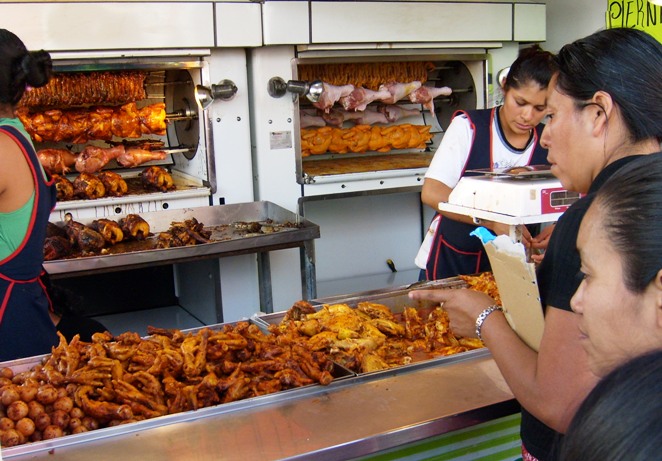 For those interested in economics, here are the prices:  Around five, after visiting my friend, I walked east on Allende, directly toward Santo Domingo church. I passed a house with a Mexican native blooming in the narrow side yard. 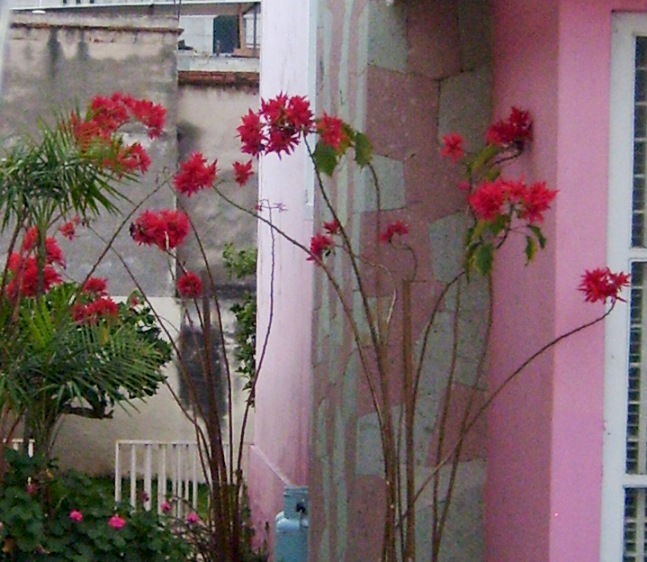 As I approach Santo Domingo, I can see something is definitely going on. 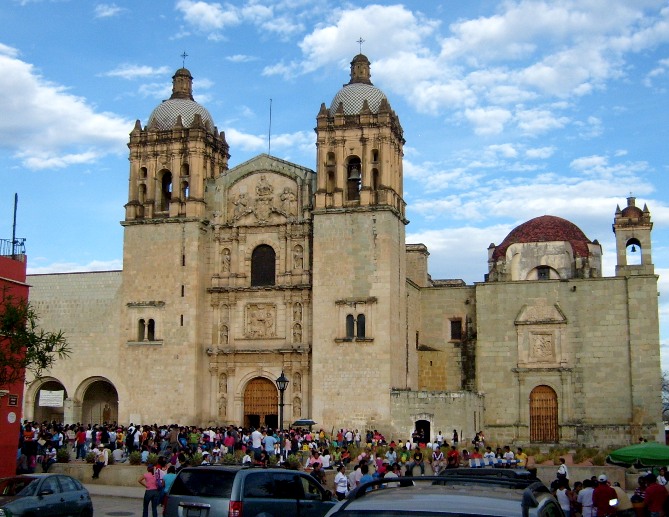 A young woman on the street in front of the church explains the purpose of the demonstration. She and the others gathered here are students and alumni of the Normal schools -- the federally supported teacher colleges. The government wants to close these schools, supposedly to create better ones. This proposition is being met with cynicism and dismay, thus the demonstration. 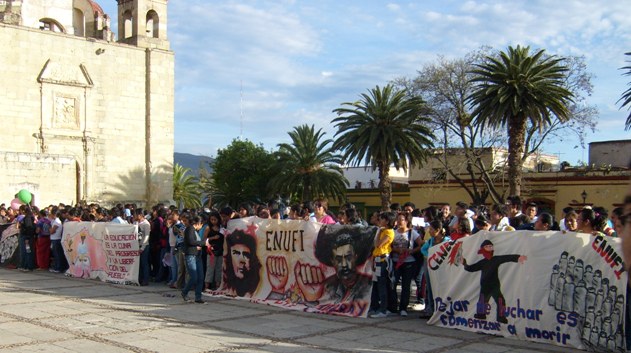 |
|
|
|
Post by bixaorellana on Feb 22, 2010 9:31:36 GMT
I make a circuit of the large plaza in front of the church, stopping to admire the agave in bloom.  As you can see, the golden light of late afternoon really brings out the green of the typical Oaxacan "cantera" -- quarried stone. 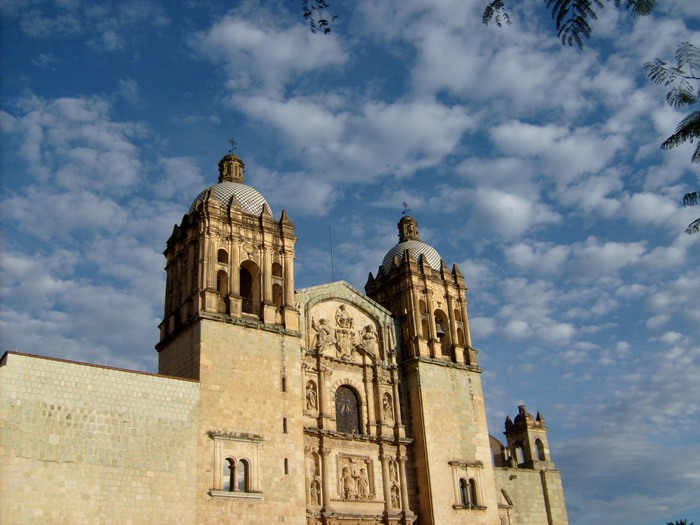 It's an exceptionally beautiful day. Even though the demonstrators are here for a serious purpose, you can see they're enjoying themselves ... 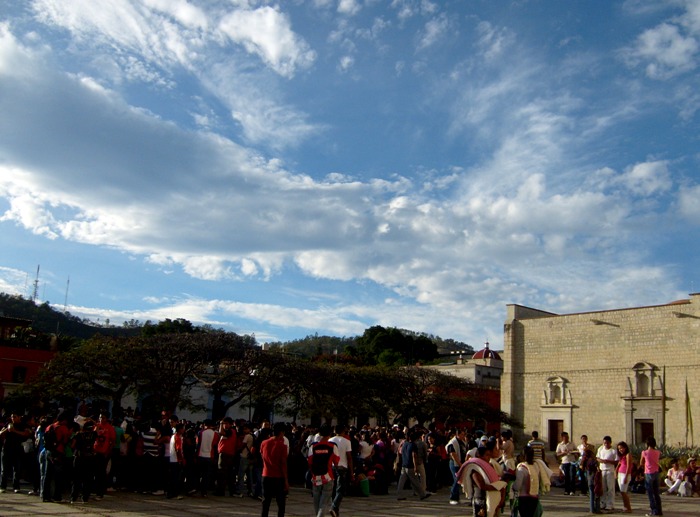 ... as are the nuns selling candies and baked goods, the tourists, and families and couples out strolling. 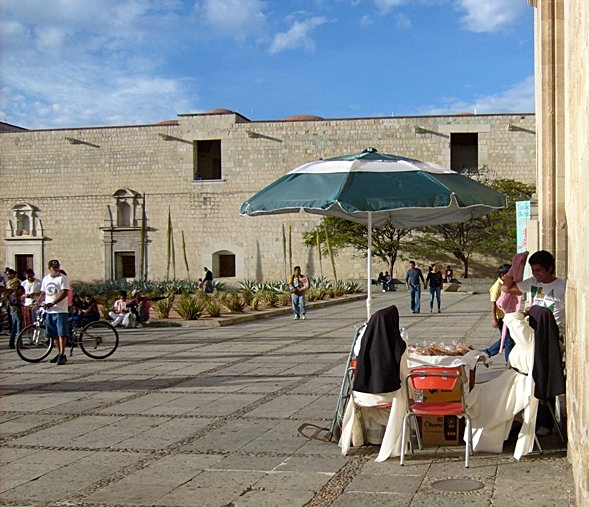 There's a door just where I'm standing to take the picture above. It leads to a little store selling religious stuff. The lady there lets me take a picture of this photo, telling me there's no date on it. 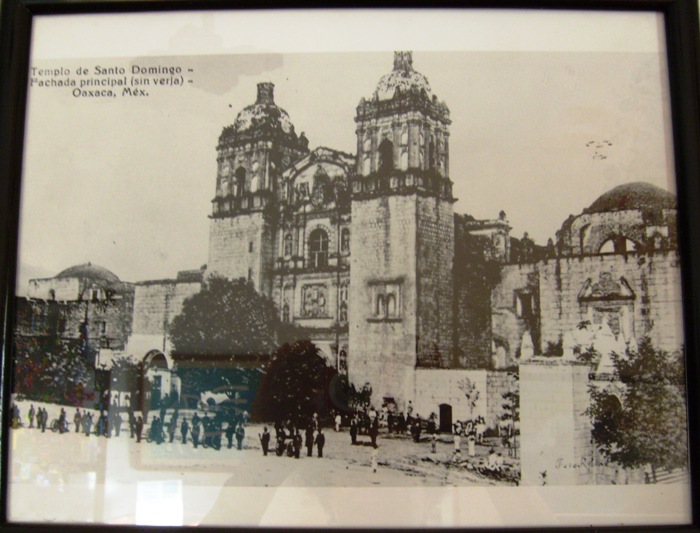 |
|
|
|
Post by bixaorellana on Feb 22, 2010 9:32:06 GMT
Leaving Santo Domingo I walk south down Alcalá, the pedestrian street, passing the side street filled with clothing and textile goods. Many of the vendors are Triqui women, distinguished by their colorful huipiles. 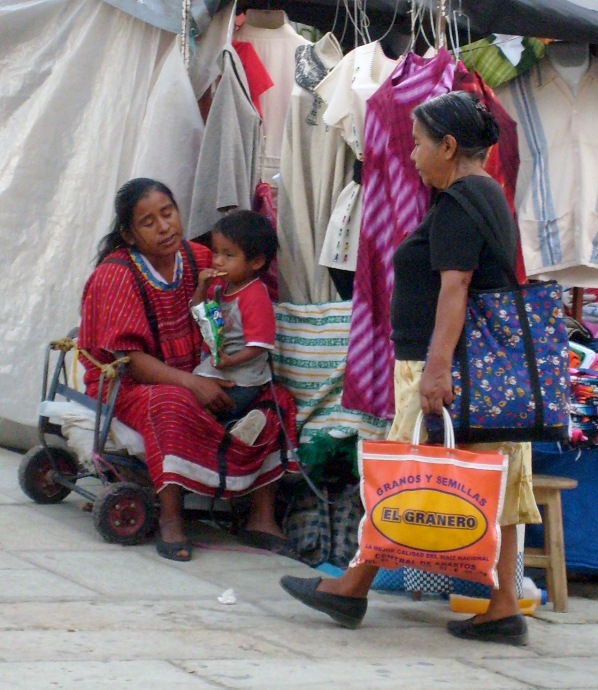 I'm approaching MACO -- Museo de Arte Contemporaneo. The scaffolding in front of the building is covered with this cloth, turning it into something delightful. 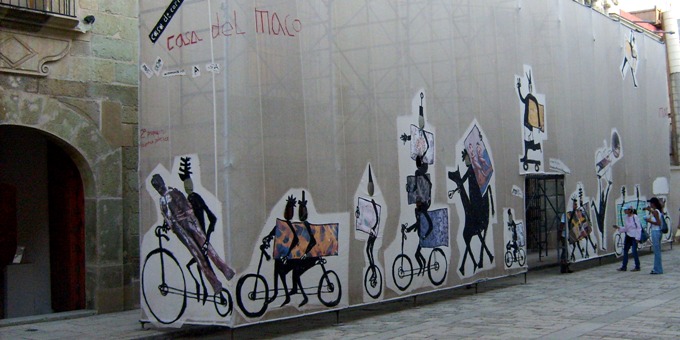 There are various of these face-shaped cutouts along the length of the scaffold covering. 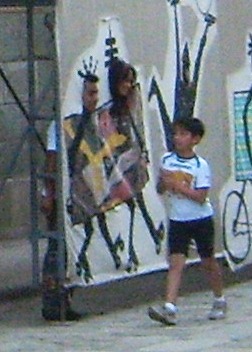 And here is Maestro Toledo himself!  Alacalá is a pretty street. These two buildings are on opposite corners of Morelos and Alacalá.  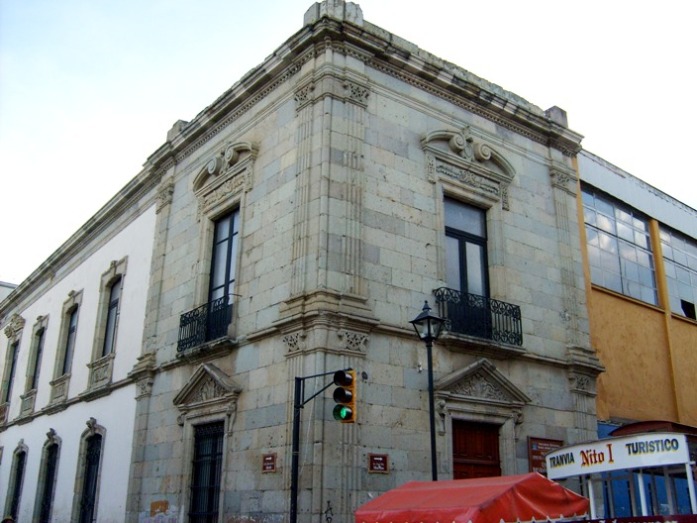 A book fair is in progress. 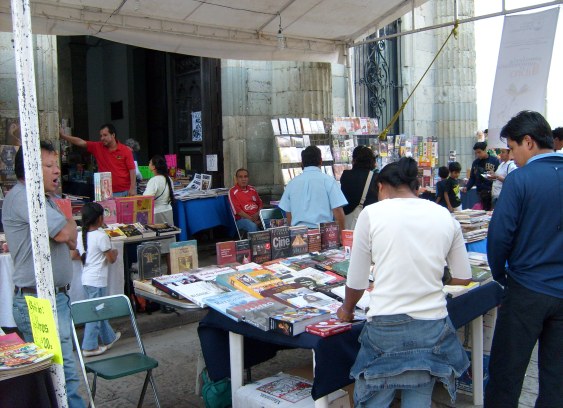 Passing behind the cathedral, I'm almost to the zocaló -- the main square. I notice the charming virgin watching over the coffee shop. 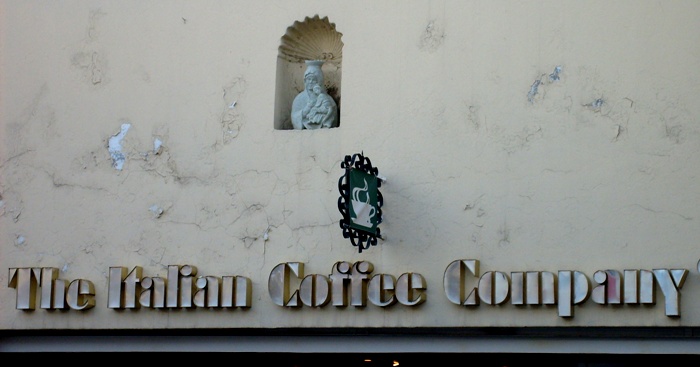 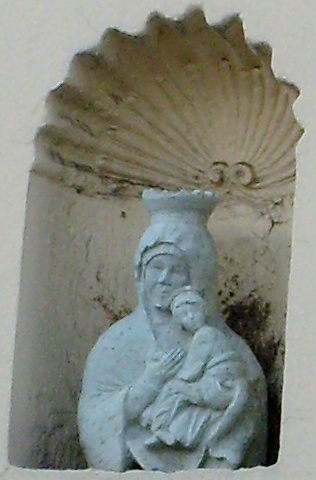 |
|
|
|
Post by bixaorellana on Feb 22, 2010 9:32:22 GMT
People are out in force in the zócalo also. 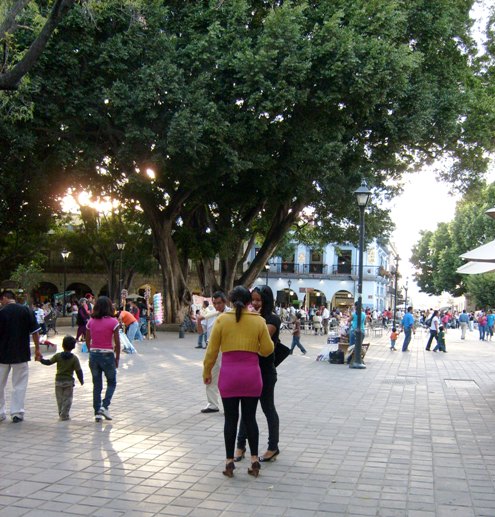 There is a man speaking into a microphone. He is part of an event coordinated with the one taking place in front of Santo Domingo. He is speaking on behalf of the APPO. 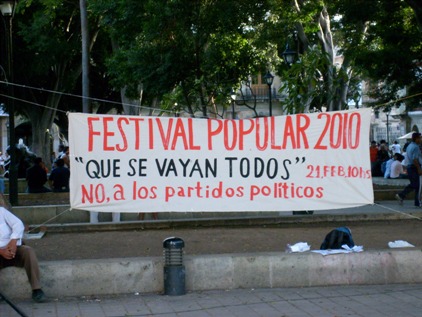 There is a little mild anarchy going on, with vendors of toys and clothing set up on the ground in front of the buildings around the zócalo, something that is not permitted. As with any crowd situation in Mexico, food vendors have appeared. This is a corner of the alameda, the large area in front of the cathedral. The zócalo is to our left, and the cathedral to our right. 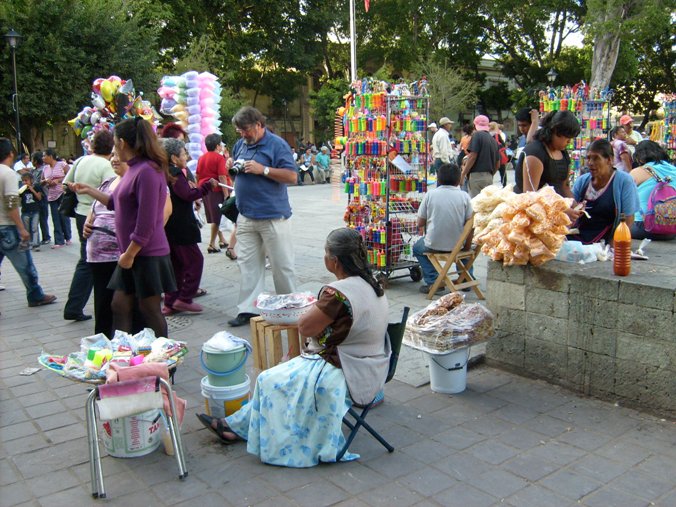 Mylar balloons -- practically a hallmark of Oaxaca.  Candy apple? 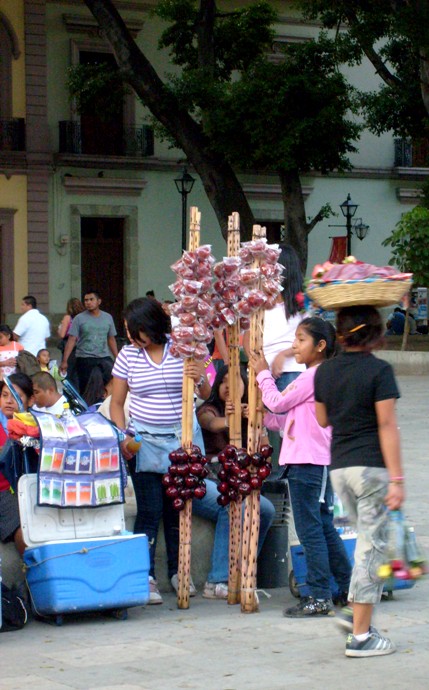 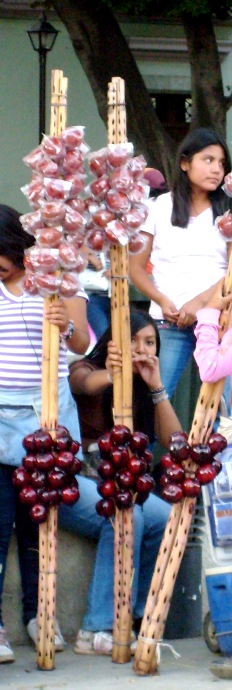 Coming to the end of the Alameda and doubling back to goggle at all the balloons. 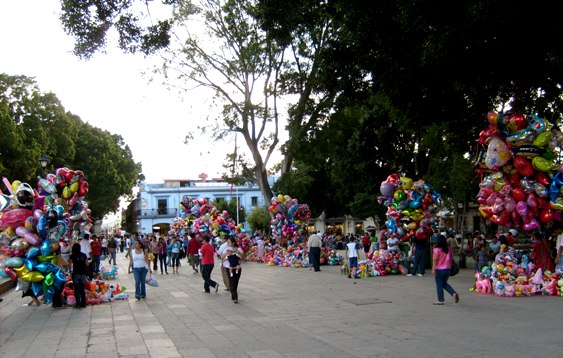 I've never bought one, but have often been tempted. 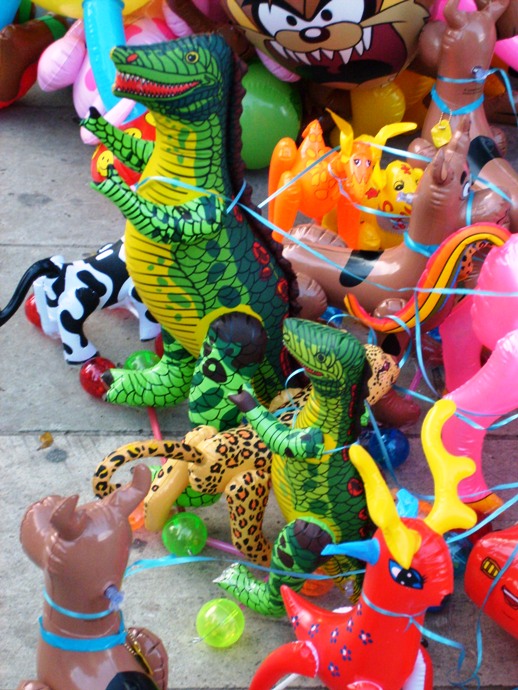 A snowball seller enjoys the day.  |
|
|
|
Post by bixaorellana on Feb 22, 2010 9:32:46 GMT
I pass through the zócalo and head back south toward where I catch my bus. Many things don't stop just because it's Sunday. The garbage is constantly collected downtown. 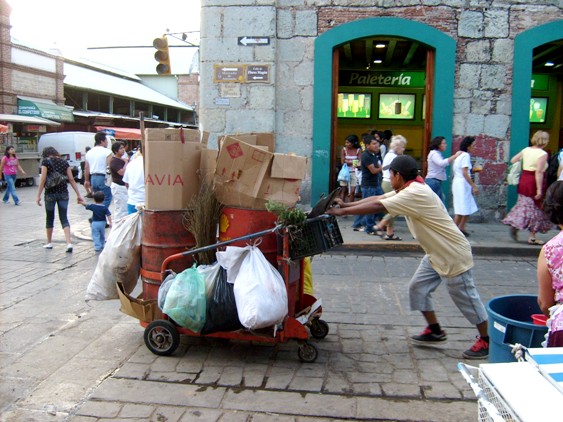 No thank you -- not today! 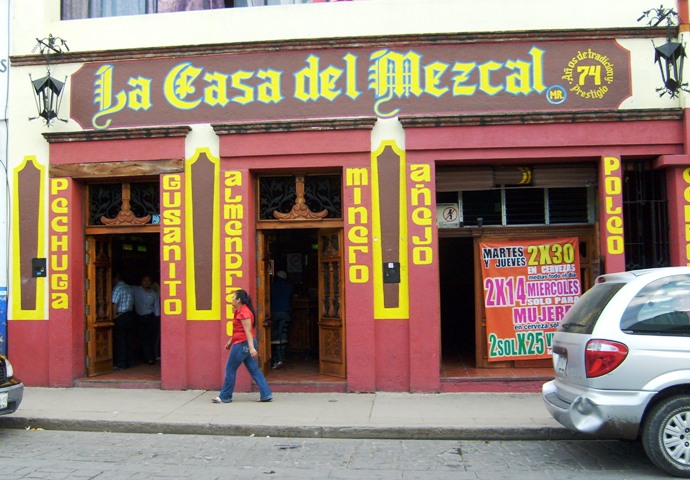 I'll pass on the grasshoppers and the pastries as well.  There are many eateries that only open at night. This one hasn't started setting up yet. However, the hungry could grab a bite from the place across the street. Their sandwiches appear to be dripping with yellow mustard, so will be avoided by certain AnyPorters. 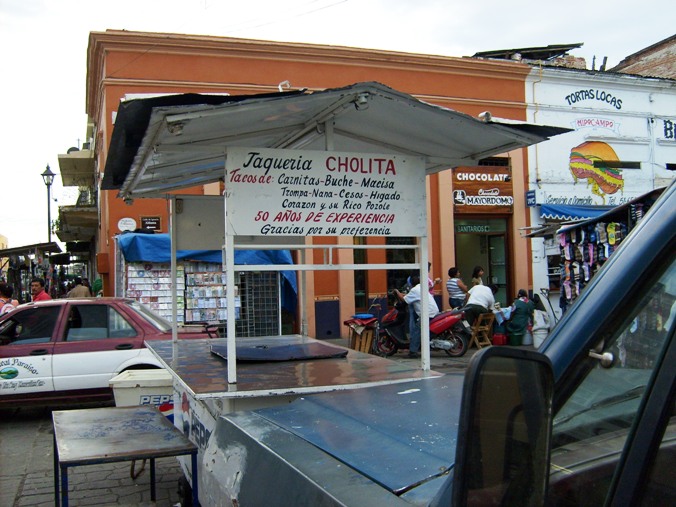 The domes of San Francisco church stand out against a perfect sky. 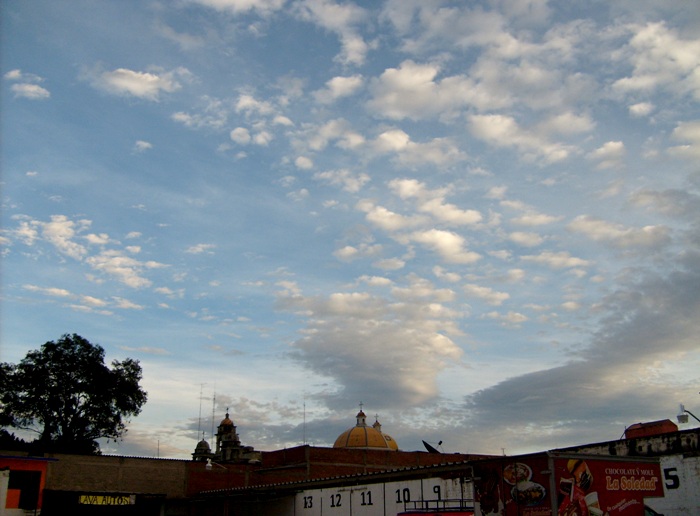 It only looks as though we're back where we began. This is my favorite chicken place, across from where I catch the bus home. 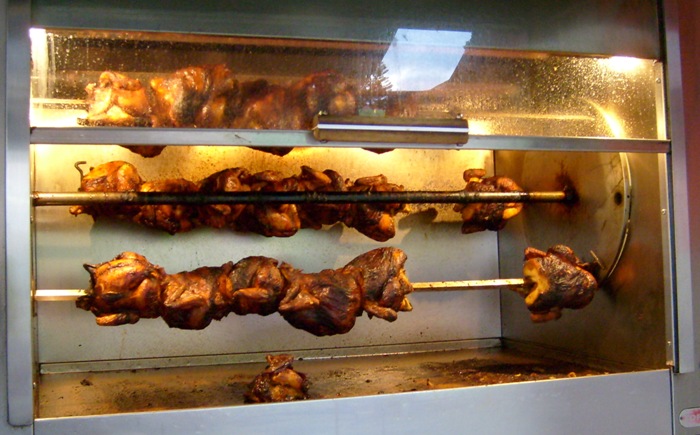 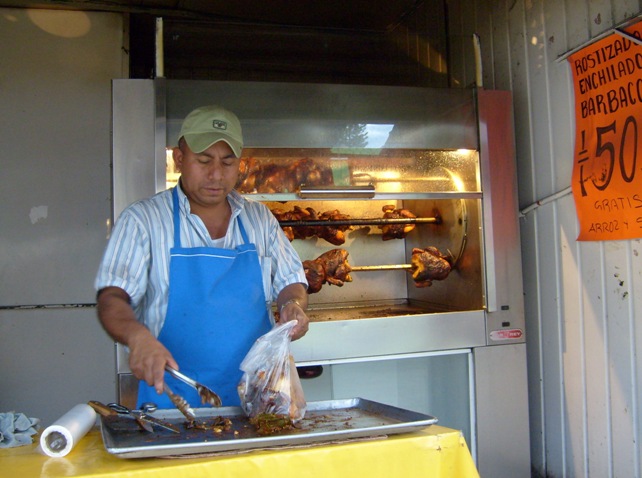 The driver has his little son sitting on his lap. One can only hope God will step in as co-pilot.  Good-bye downtown, I'm heading home. |
|
|
|
Post by bjd on Feb 22, 2010 10:18:20 GMT
Thanks, Bixa. This all reminds me of why I like S America.
|
|
|
|
Post by Deleted on Feb 22, 2010 10:57:23 GMT
Great thread Bixa. Why is that coffee shop called The Italian when Oaxaca is a coffee mecca in and of itself? Most peculiar.
This brought back some great memories,the place does seem timeless. Not so very much different than 10 or so years ago. Which is a good thing.
Loved seeing the agave blooms,and of course the by now,famous,fantastic clouds.
Thanks for this.
(I'm still kicking myself for not having purchased a collection of Lorca's poems in the original Spanish from one of those book vendors!!!)
|
|
|
|
Post by Deleted on Feb 22, 2010 18:32:57 GMT
Absolutely wonderful report, Bixa. Mexico is always so incredibly colorful. I had no idea that the agave had so many uses until I clicked on the link -- or that it could cause nasty itching for up to a year!  |
|
|
|
Post by lola on Feb 22, 2010 19:14:39 GMT
Tortas locas, dripping with the finest yellow mustard. Yes.
So fine, Bixa. Love the sky, and the balloons.
|
|
|
|
Post by bixaorellana on Feb 22, 2010 22:06:06 GMT
Thank you, Bjd. That's how I felt looking at your threads on Colombia. Even though I live in a latin American country, I thought "Oooo, I wanna go there!" (to see Bjd's threads, go here.) Casimira, The Italian Coffee Company is a Mexican chain serving excellent coffee. The name in English may not seem any odder to people here than restaurants in the US called "Chez Pierre" or whatever. Kerouac, your remark made me read all the way down to the part about the itching. I've never been afflicted with it for that long, but have been pricked by agave thorns enough that I know about the itching. Another use for agave leaves is as plates. There is a town in Oaxaca called Nochixtlan known for its barbacoa. Cracked corn is put below the roasting goat so that the juices drip down and cook and flavor the corn. It's served on slabs of roasted agave leaf. A complete piece of trivia: the Spanish for agave is "maguey" (mah gay), leading to a silly phrase similar to our "Later, 'gator" -- OK, maguey! Lola, when you come visit I will buy you a shiny balloon. |
|
|
|
Post by hwinpp on Feb 23, 2010 2:48:13 GMT
In the first chicken roaster, are those turkey drumsticks below the whole chooks? Those look huge!
Nice Sunday afternoon excursion, Bixa.
But I still know nothing of the city you live near. Is it the provincial capital? How big is it?
|
|
|
|
Post by bixaorellana on Feb 23, 2010 4:38:24 GMT
Yes, turkey legs, HW. I had another picture that I must have flushed that showed the sign advertising the legs. I will endeavor to tell you more about Oaxaca de Juarez, capital city of the state of Oaxaca, but in the meantime, you can peruse the price list from the chicken feet and turkey drumstick emporium. Some of the words and prices were obscured by that overhead pipe. ½ kilo adoboed wings, 25 pesos ¼ kilo [something] garnished with onion, 10 pesos ¼ kilo ribs [something] roasted, 25 pesos ½ kilo adoboed (chicken) feet, 13 pesos ½ kilo adoboed pigs feet, 25 pesos ½ kilo adoboed potatoes, 10 pesos 6 roasted heads, 10 pesos  www.oanda.com/convert/classic?user=onlineconversion&lang=en www.oanda.com/convert/classic?user=onlineconversion&lang=en |
|
|
|
Post by hwinpp on Feb 23, 2010 5:10:27 GMT
You know me well, by now, Bixa...  Thanks for the prices, they're very similar to here. While we don't have chicken heads, we do have chicken backsides! In fact I often get one free when I go to our local chicken BBQ  |
|
|
|
Post by Deleted on Feb 23, 2010 5:54:31 GMT
We don't have chicken heads either. I am crushed.  |
|
|
|
Post by imec on Feb 23, 2010 15:42:20 GMT
Fantastic bixa! I REALLY fell like I've had a day out in Mexico! The skies are so beautiful - and I'm sure I've never seen so many balloons! Shame about the sandwiches - the chicken looks great though!
|
|
|
|
Post by Kimby on Feb 23, 2010 19:50:24 GMT
Thanks for this bixa. All of our pictures of Oaxaca in 1991 were lost in the mail when we sent in 5 rolls of slide film for processing and only four came back. Fuji compensated us for the price of the film and mailer, but the pictures were priceless.
Can you perhaps do a thread of some of the area weavers?
And the ruins nearby?
And the strange pole twirling event?
Those pictures remain as vivid in my mind as the ones we did get back from the processor - that are gathering dust in a slide carousel tray in the closet....
|
|
|
|
Post by bixaorellana on Feb 23, 2010 23:28:50 GMT
Thank you, Imec ~~ you know perfectly well of whom I was thinking (besides HW, of course) when I made those chicken pose for the camera. Oh Kimby ~~ I feel so stupid, as I did not realize you had been here. I'm a little jealous that you made it as early as '91, since with every year Oaxaca becomes more modern. I don't begrudge it that, but selfishly wish to have experienced as much of the picturesque part as possible. Yes, I would be delighted to a thread on the weavers and on some of the ruins. I have to confess I don't know what the pole twirling is.  Could you give me more of a hint, please. Pee Ess ~ I can't remember when you were away this year, but you may not have seen my visit to Arrazola, an animal carving craft town.I have had Car Issues which (knock wood) are perhaps being resolved and which would make me a much better roving reporter. Nothing could ever replace your own pictures, but here are a few more from Sunday. Two are details of the area over the door you can see on the right side of Santo Domingo as you face it. The one with the bright sky is looking down Independencia towards the setting sun as I crossed towards the back of the cathedral. The golden domes are atop San Francisco church. |
|
|
|
Post by bixaorellana on Feb 23, 2010 23:37:17 GMT
HW, I did not forget your request to know more. Oaxaca is a bustling city, as it's the capital and hub of the whole state. The main public hospital is here, for instance, as is the state supreme court. The huge downtown market draws vendors and buyers from all over. From the Moon Handbook, Oaxaca, by Bruce Wipperman: Oaxaca de Juárez (pop. 350,000, elev 5,110 feet / 1,778 meters), the capital city of the state of Oaxaca, occupies the strategic intersection of the three great arms of the Valley of Oaxaca.
From the city, the three sub-valleys diverge south, northwest, and east.Here is a short history of Oaxaca, heavily cribbed from Bruce Whipperman. There have been permanent settlements in the valley of Oaxaca since at least 8000 bc, although humans are believe to have been here for around 20,000 years. By 2000 bc, there were towns with stone houses for the upper classes, pyramids, temples and small factories producing specialized merchandise such as jewelry. Around 600 bc, Zapotec-speaking people founded Monte Albán atop a mountain above the present city of Oaxaca. It was a metropolis of perhaps 40,000, controlling a large area of southern Mexico and with diplomatic and trade relations with distant kingdoms. For unknown reasons, by 800 ad Monte Albán had gone into almost complete decline. Zapotec-speaking city-states grew up in the valleys to take over areas once ruled by Monte Albán. Later, Mixtec-speaking people from the northwest invaded the Valley of Oaxaca, taking over Monte Albán, subjugating the Zapotec city-states, and ruling until the Aztecs invaded during the 1440s. The Aztecs fought the combined forces of the Zapotecs and Mixtecs for over a decade until a final victory in 1456. They then established a garrison on the hill overlooking the present city of Oaxaca, which grew into a model colony by 1500. On Christmas Day 1521, conquistador Francisco de Orozco and his soldiers replaced the Aztecs on the hill and renamed it El Cerro del Fortín. Spanish settlers received a charter from the Spanish king for their town, although they’d been repeatedly harassed by Hernán Cortés, who wanted the rich valley for himself. He eventually triumphed, receiving the title of Marqués del Valle de Oaxaca and a grant of hundreds of acres and rights to the labor of thousands of indigenous subjects. The townspeople of Oaxaca received a one-league square in 1532 which is the core of the modern city of Oaxaca. By the 1850s, Benito Juárez, a pure Zapotec, was rallying liberal forces in the War of the Reforms against the ruling oligarchy. His first term as president of Mexico was interrupted by the French invasion and the installation of Maxmilian as emperor of Mexico. After a five year struggle, Maxmilian was defeated and executed in 1867. Juárez instituted great reforms, many of which remain in force. Another Oaxacan, Porfirio Díaz, became president in 1879 and ruled for 34 years. Although he did much to modernize Mexico, the human cost was brutal and property and power concentrated among the rich Mexicans and their foreign friends. In 1910 there was a revolt which ousted Diaz and put the PRI (Institutional Revolutionary Party) into power that lasted up until the election of Vicente Fox in 2000. To a large degree the PRI retains control over much of what goes on in Oaxaca, leading to deep and volatile tensions. In this thread, I have tried to give an overview of the issues that sparked the demonstrations of 2006 and how the struggle continues. Please go here for accompanying pictures. |
|
|
|
Post by lola on Feb 24, 2010 0:42:42 GMT
Beautiful, bixa. Thank you.
And yes please on the balloon.
|
|
|
|
Post by bixaorellana on Feb 24, 2010 17:44:07 GMT
Thank you, Lola and everyone. Wish you could all show up here en masse and we'd go exploring together. We don't have chicken heads either. I am crushed. A question: Is that supposed to read "crusted" -- poor English to say that you only get fried chicken? If so, does it belong on the food board? |
|
|
|
Post by hwinpp on Feb 25, 2010 1:27:38 GMT
Thanks for the info, Bixa.
|
|
|
|
Post by Kimby on Feb 25, 2010 16:14:59 GMT
Oh Kimby ~~ I feel so stupid, as I did not realize you had been here. I'm a little jealous that you made it as early as '91, since with every year Oaxaca becomes more modern. I don't begrudge it that, but selfishly wish to have experienced as much of the picturesque part as possible. Yes, I would be delighted to a thread on the weavers and on some of the ruins. I have to confess I don't know what the pole twirling is.  Could you give me more of a hint, please. Pee Ess ~ I can't remember when you were away this year, but you may not have seen my visit to Arrazola, an animal carving craft town.Nothing could ever replace your own pictures, but here are a few more from Sunday. Two are details of the area over the door you can see on the right side of Santo Domingo as you face it. The one with the bright sky is looking down Independencia towards the setting sun as I crossed towards the back of the cathedral. The golden domes are atop San Francisco church. Thanks, bixa for the link to the Arrazola thread. I HAD missed it (I'm sure there's a LOT I miss on here, so always appreciate the heads-up to a good thread). We visited Oaxaca for a few days of a 2 week trip that began in Villahermosa, wound south with rented VW bug through Palenque to Chiapas and San Cristobal de las Casas, then to the coast at Puerto Arista, then to Oaxaca then flew to Mexico City and home. I dug out my journal from the trip (this is pre-computer so I do not have a version on my PC I could paste into a thread on here) and revisited our days in Oaxaca and environs. I do not want to thread-jack with a trip report here, but will say that the pole dancers are called voladores, and they hang by their feet from ropes that twirl them as they unwind down the pole www.houstonculture.org/mexico/flyers.html - we saw them at Mitla. en.wikipedia.org/wiki/Danza_de_los_Voladores_de_PapantlaAlso we visited the ruins at Yagul and Monte Alban in addition to Mitla (all these pictures were lost) and explored Santa Ana de Valle and Teotitlan de Valle to see the rug weavers. We had great photos of the cochineal beetlles used to make red and purple dyes:  and the weaving fabrica of the Vasquez family in Teotitlan, where we bought a rug that hangs in our living room. We loved Mexico and hope to return to this area to "retake" our pictures and new ones. (Digital this time, no pics lost in the mail!) We also did a 3-week Yucatan trip in 2003... |
|
|
|
Post by bixaorellana on Feb 25, 2010 19:11:34 GMT
My gosh, Kimby -- you all covered a lot of ground in two weeks. It would be absolutely fabulous if we could meet. Hurry up and come back! Ahh -- okay, I know about those pole dancers, but since I thought you were referring to some in the state of Oaxaca, I was confused. As far as I know, they don't exist in this state. I got very close to Papantla on my last trip, but we ran out of time. It's certainly not thread jacking to show that wonderful picture of cochineal being ground, something so very specific to this area. Here's a picture I took of a cactus near my house that has the cochineal beetle infestation. It's so amazing to scratch one of those white patches and have your fingernail stained by the deep, deep purple-red juice that oozes out. Looking through my photos, I could kick myself that I've never taken pictures of the most of the rugs I've given as gifts. The two below were wedding gifts to my niece.  Kimby, do you all have a scanner? It would seem to be an item custom-made for you. Just think, you wouldn't even have to re-type stuff if you scanned it. Not to blow my own horn too much, but please check out the N.America boards and Post Cards for other threads I've posted about my area. There's one on birds there, hint hint. |
|
|
|
Post by Kimby on Feb 26, 2010 0:17:37 GMT
My gosh, Kimby -- you all covered a lot of ground in two weeks. It would be absolutely fabulous if we could meet. Hurry up and come back! Ahh -- okay, I know about those pole dancers, but since I thought you were referring to some in the state of Oaxaca, I was confused. As far as I know, they don't exist in this state. I got very close to Papantla on my last trip, but we ran out of time. Kimby, do you all have a scanner? It would seem to be an item custom-made for you. Just think, you wouldn't even have to re-type stuff if you scanned it. Not to blow my own horn too much, but please check out the N.America boards and Post Cards for other threads I've posted about my area. There's one on birds there, hint hint. It might have been closer to 16 days, but not our usual 3 weeks. We usually pack a lot into our trips. (Shoulder season means not a lot of lollygagging on beaches.) We saw the voladores at Mitla, right in your back yard, no? I wonder if it was a travelling troup rather than locals. I DO have a scanner, attached to my old computer and incompatible with the Vista machine now on my desk. It even has character recognition software, but it doesn't do handwriting (and my journals in tiny bound books in pencil) would not be legible as .jpg images. I will try to photograph our Oaxacan rug and post it on here. It's rather different from the two you show. Thanks for the tips. I never seem to have time to visit all the nooks and crannies of this forum (much less finish my own posting on Australia!) |
|
|
|
Post by bixaorellana on Feb 26, 2010 7:32:24 GMT
Yep, Mitla is right here in the valleys of Oaxaca. I can't find any references to voladores there, but that doesn't mean they don't (or didn't) exist. Perhaps there are no more practitioners around here? I'll keep checking. I did find this, though, which is a super fun educational toy. It made me dizzy! I don't know why the colors are good in some parts and lurid in others. |
|
|
|
Post by Kimby on Feb 26, 2010 14:51:14 GMT
Yep, Mitla is right here in the valleys of Oaxaca. I can't find any references to voladores there, but that doesn't mean they don't (or didn't) exist. Perhaps there are no more practitioners around here? I'll keep checking. I did find this, though, which is a super fun educational toy. It made me dizzy! I don't know why the colors are good in some parts and lurid in others. I'm guessing that the voladores were a travelling troup, then. And we were just lucky to be there the same day they were. That photo navigation of Oaxaca is fun - you can set it to spin 360 degrees (and pretend that you are a figure skater in a spin!). Almost enough to make me queasy. |
|
|
|
Post by Kimby on Feb 26, 2010 16:21:54 GMT
 Our Oaxacan rug, from the Vasquez family fabrica in Teotitlan de Valle. We also got a rug from the market in Santa Ana de Valle, and gave it to Mr. Kimby's brother, but the photo of that one was a slide, and might have been in the batch that was lost in the mail. (I have visions of that roll of unprocessed film riding around under the seat of a mail truck somewhere...) |
|
|
|
Post by bixaorellana on Feb 26, 2010 20:04:32 GMT
That's a beauty! It has a great example of the greek-key design that's one of the hallmarks of the Teotitlan rugs. If you reeeeally wanted a pic of the one you gave to your brother-in-law, try looking through family photos. It's hard to get a decent picture that way, though. I chopped this out of a Christmas photo taken at my mother's house. |
|
|
|
Post by Kimby on Feb 26, 2010 20:08:22 GMT
bixa, that would work in a normal family. Mr. Kimby's brother however is far from normal. All his possession, including the many wood carvings we've brought him from our travels as well as the aforementioned rug, are permanently in storage while he lives in a half-empty house and builds his dream home. A project that has barely advanced in 4 years. So it's not likely to end up in a family photo anytime soon.
Wish we had that stuff back.
|
|
|
|
Post by bixaorellana on Feb 27, 2010 17:25:44 GMT
Both Spindrift and Kimby have expressed an interest in seeing some of the craft villages around Oaxaca. In time I'll do reports on them, but in the meantime, here are some examples of the local crafts. Many women still wear the distinctive dress of their regions, as you can see in the first picture in Reply #2. This lady is also a Triqui and is standing in the same vending area, the Plazuela Labastida. 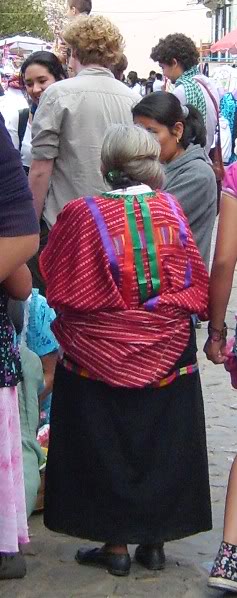 There you will find dresses and blouses in abundance, as well as shirts, shawls, and other clothing from further afield. 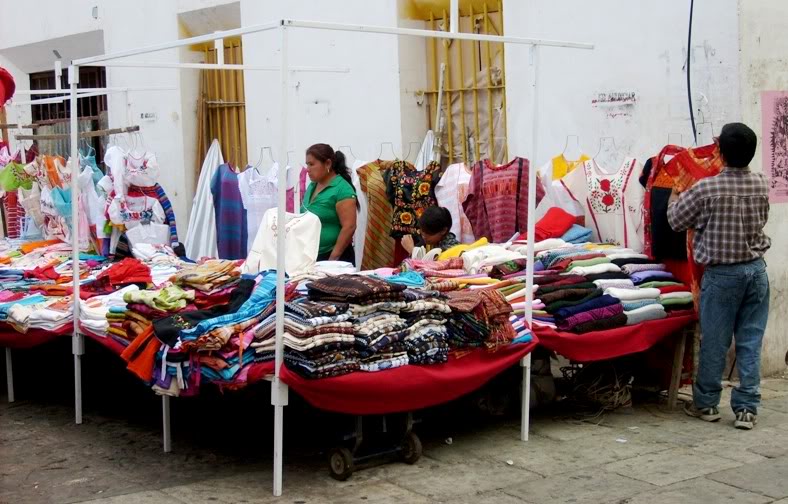 Quite a few of the traditional dresses (huipiles) are hand woven. The women of the Isthmus of Tehuantepec are easily identified by their long skirts and their fabulously embroidered blouses. 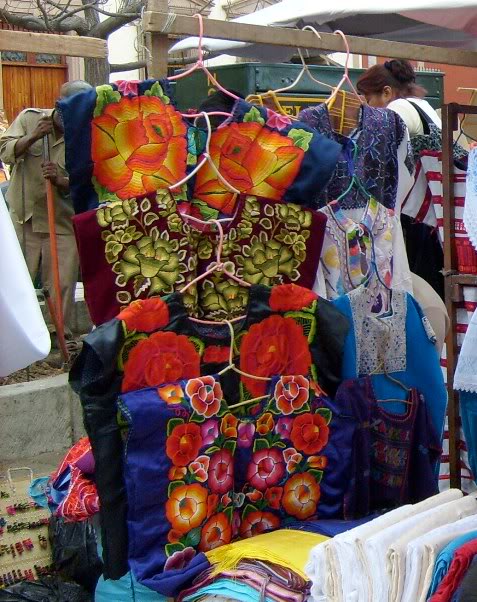 The everyday blouses are not always so elaborate, but will always feature lots of embroidery, sometimes machine embroidery in geometric designs. The seated woman in the third picture in Reply #3 above is from the Isthmus. This lady is from Santo Tomás Jalieza. She is working on her waist loom, making more items such as those seen on the ground next to her. Her town is known for this particular kind of textile, as well as embroidered leather. You can see a little of the embroidery skill on her apron. 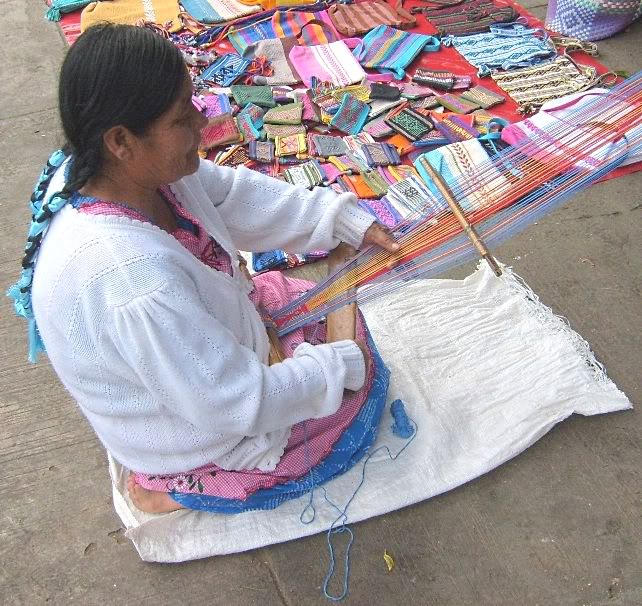 Another kind of weaving is that done with the fronds from the dwarf palms in the dry upper Mixteca region. The soft baskets (tenates) and the mats (petates) are in daily use all over the state. 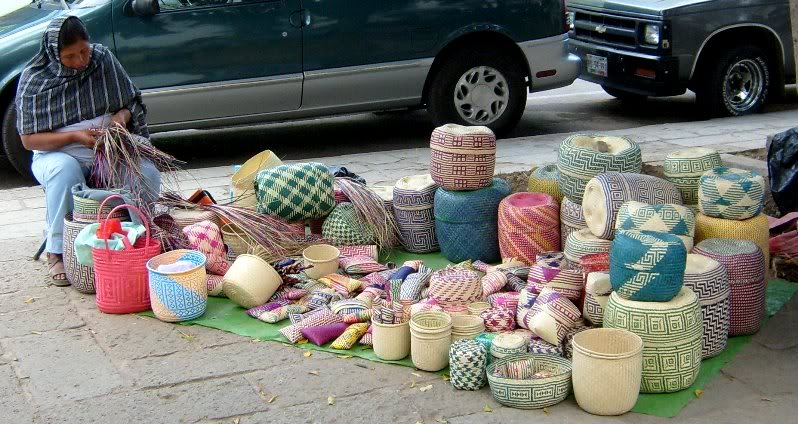 |
|